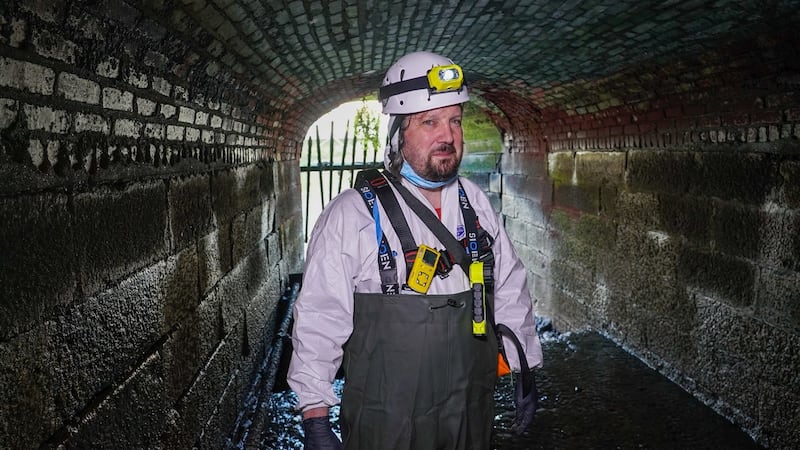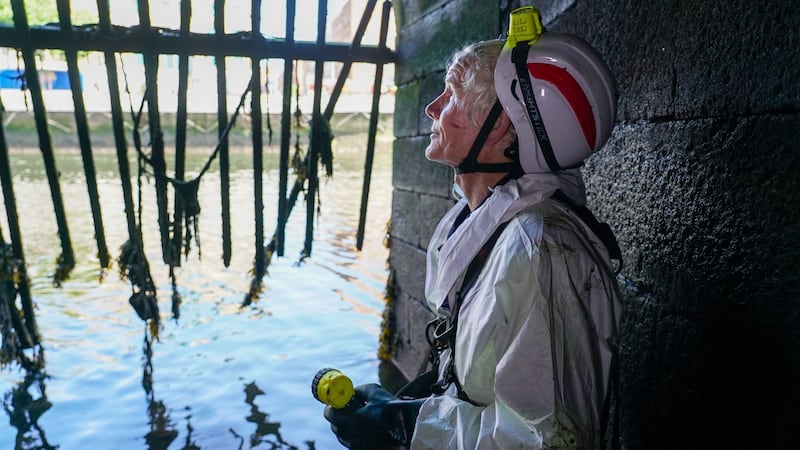I’m standing in a red brick tunnel at the bottom of a manhole near the Palace Street entrance to Dublin Castle.
I’m in full PPE, hard hat, head torch and waders, with a harness to winch me to a tripod when I’m climbing in and out. I have a gas monitor hooked to my belt which beeps comfortingly every few minutes, assuring me that all is well. The Poddle river, which is around six inches deep as I stand there, is running by my feet and Dave Greene, a Dublin County Council employee for 49 years, is speaking rapturously about the city’s underground pipes and tunnels.
“It’s a pilgrimage we’re going on,” he says. “You’ll be a new person when you leave.”
It rises in Cookstown, northwest of Tallaght and comes through Tymon Park, Terenure, Mount Jerome and along the South Circular Road
Another council employee, executive engineer Ross Flanagan, walks behind us as we move and is keeping track of time and making sure we're safe. Not willing to be responsible for losing two Irish Times staff members in a subterranean waterway, they've ensured we've done a day of "confined spaces" training, and several more Dublin City Council personnel check in on us at different manholes along the way. I ask one of the men if they're coming with us as I'm descending the ladder and he laughs. He's part of the emergency rescue team, he says. "You really don't want to see me down there."
So it’s me, Dave Greene, Ross Flanagan, Enda O’Dowd (Irish Times cameraman) and, though I don’t actually spot them, probably some rats. Rats are called “the sewer man’s friend” according to another man at the entrance. “Because if you see one, that means that there’s no gas, like canaries in a coal mine” he says. You can also catch Weil’s Disease from them though, something else to worry about that I learned on the day-long training course.
Unlike the actual sewer system, there's unlikely to be dangerous gas in the Poddle now (though it was treated as a sewer at one point in its history). It's the fifth largest of Dublin's waterways. It rises in Cookstown, northwest of Tallaght and comes through Tymon Park, Terenure, Mount Jerome and along the South Circular Road. It's largely culverted through tunnels now at its lower reaches, but Vikings could once take their boats up the Poddle from the Liffey. Back then it was around 80ft wide and 40ft deep and it helped form a pool around where the Castle Gardens now sit in the walls of Dublin Castle. This was the "black pool", the Dubh Linn, after which the city is named.
For hundreds of years Dubliners drank its water and used it to energise their mills and it was the city’s main water source before pollution, disease and flooding made it seem like more of a nuisance than a help. “They put a roof over it in the 1860s,” says Greene. “It had a lot of gifts this river. But though they loved it, they had to put it underground and tame it a bit.”

Now out of sight and out of mind for most Dubliners, it lives on in local lore. In the revolutionary era there were tales of prisoners escaping Dublin Castle through these tunnels. In 1985 some hapless bank robbers attempted to tunnel into the nearby Allied Irish Bank from here. Sometimes the Council come down in response to reports of people seen messing with manholes or heard underground. Sometimes they take security personnel to check it for threats before important State visits. More commonly they’re down here to check if any of the brickwork needs to be reinforced.
It’s not polluted now. The water at my feet looks remarkably clear. If there’s a smell down there, it’s more the musty damp smell of underground brick. At the bottom of the ladder we can go left or right but Greene has a route in mind. The four of us walk back through the running stream beneath the gate of Dublin Castle before turning right and coming to a chamber in which, facing us, are two red brick arches. Both bring the river in parallel streams out towards Ship Street. “The reason they split this culvert in two is in case they built one single culvert and it was blocked with timbers or bicycles,” says Greene. “If you were to travel back either of those culverts [they]’d meet one another to shake hands at the Birmingham Tower and Record Tower.”
He notes a sharp section jutting between the arches that looks like the prow of a boat. “This could be a reminder of the Vikings,” he says. “Why did they stop here [in Dublin]? Maybe the Poddle was a miracle they were hoping to see… People would wash their clothes and drink the water of the Poddle.” Children once swam here in the now underground river, he says. “It’s flowing. It’s constant.”
To our right as we face the arches, there’s a narrow tunnel that takes the Poddle beneath Dame Street towards the River Liffey. This is the direction Greene wants us to take in order to get to the bigger river while we’re still at low tide. “The tide won’t rest for anyone,” he says, ominously, but he doesn’t seem too worried.
Decades coming down here means that Greene always knows what's above him. At one point, he gestures upwards and says: "If you got out at this manhole you'd see Eddie Rockets restaurant and also you'd see the Olympia Theatre where our great actors and musicians perform… We're really going back in time now."
It’s not an entirely easy route. As we walk, the roof gets much lower in places and we have to stoop and bend. At two locations large sewer pipes cross our path at around waist height and we have to climb over them. Greene can tell us exactly where these sewer lines come from and where they are headed.
From time to time, Greene points out bits of loose brickwork or stone on the watery floor on which we're walking. Workmen sporadically have to come down for repairs
It’s only about 320 metres to the Liffey, but the breathing equipment we have to carry for safety reasons is heavy, it’s hot beneath the PPE, and clambering over the pipes and walking in a crouch is tiring. Greene doesn’t seem tired. He seems energised. “When I started 49 years ago I just got addicted to the underground,” he says, at one point.
There are little oddities along the way. The redbrick gives way to grey stone. At one point the stream is joined by another culvert that leads back to the manhole at which we entered. We would have come this route, if we had walked in the other direction when we first entered the tunnel. At another point we can see what appears to be a little room to our left. “That could be a basement from times past,” says Greene.
From time to time, Greene points out bits of loose brickwork or stone on the watery floor on which we’re walking. Workmen sporadically have to come down for repairs. “Everything has a life, like ourselves, and the walls have a life and have lived through the centuries and maybe they’re saying goodbye to us now, a lot of the bricks,” he says. “These are the walls from 1860 and they’re still standing today… The people who built it are in the heavens now – stonemasons, general workers.”
Does he feel a bond with those people? “You do feel a connection with them. Maybe they keep you safe on the journey.”

As we get closer to the river the sound of running water gets louder. We reach a section where we can stand straight once more and ahead of us we can see the Liffey through an archway with a sort of portcullis. We walk to the edge of the archway and look out on the river, across to the North Quay. “This is where the Poddle says goodbye to us and meets the oceans of the world,” says Greene.
We take it all in for a little while before Greene suggests that we head back to the surface. It’s unlikely that the water will rise much today, he says, but “on extreme days of high flood and heavy rain you may not be able to see this arch.”
At one point when we’re walking back through the tunnels and clambering over pipes, I bang the low roof and knock my head torch from my helmet into the river. The way ahead is pitch black and for a moment I get a sense of how terrifying it would be to be down here without safety gear and a team of people who know the way. Greene hands my torch back to me. “Without a torch you’d be going around in circles down here,” he says.
He seems completely unafraid. He stops at one point and crouches to let the little river run over his gloved hand. "The river Poddle is quiet now, like all the rivers in Ireland but from time to time they let us know that they're very much alive, just like angels and saints," he says.
Soon we’re at the chamber with the double culvert again and, after stopping there for some photos, we’re back to the manhole at which we entered. I climb up the ladder and out into the daylight of Dame Street. “We’re leaving the old city of long ago and we’re entering the more modern Dublin,” says Greene as he emerges shortly after me. “We’re coming towards the end and we’re travelling back to the new century.”











